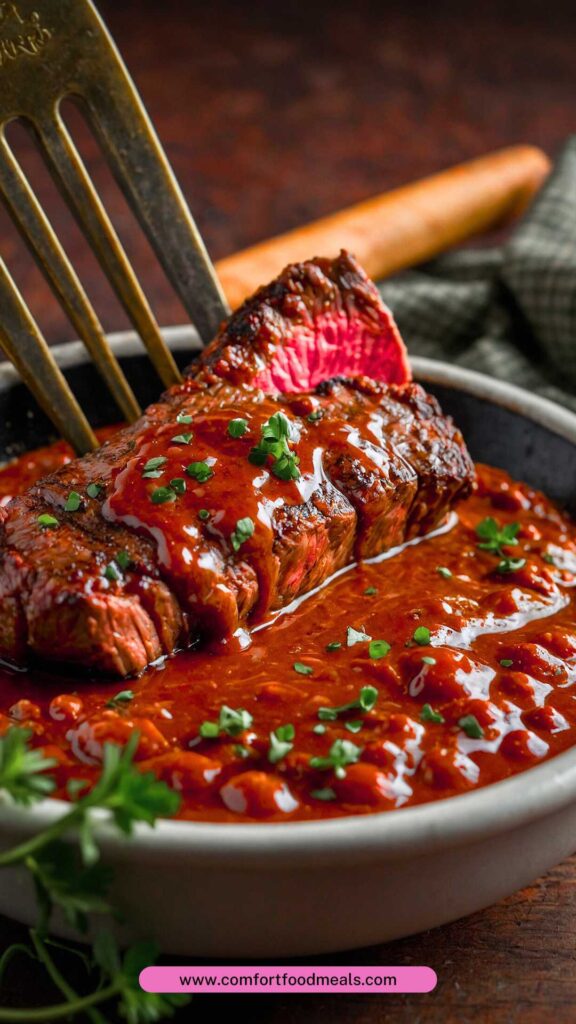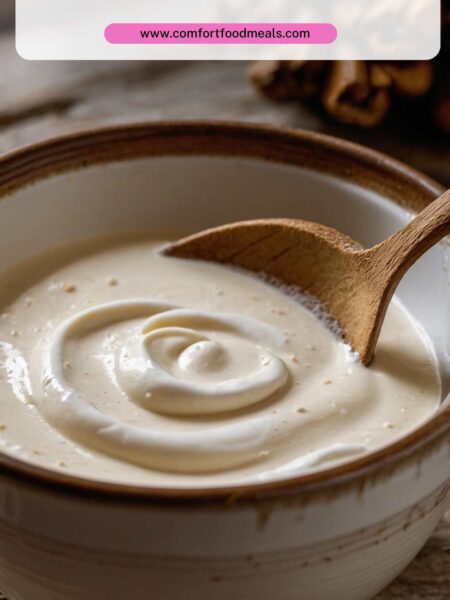When you think of a mouthwatering steak dinner, your mind might leap to a classic side like creamy mashed potatoes or crisp, seasoned asparagus. Whatever you choose, consider this: a great steakhouse meal is all about balance.
You could serve the steak with a side salad drizzled with a homemade vinaigrette or opt for grilled veggies to add color and nutrition. And let’s not forget the role of a superb baked potato, fluffy and loaded with butter and sour cream. These sides complement any steak beautifully.

One evening, I found myself reminiscing about my last visit to Peter Luger Steak House in Brooklyn—a legendary establishment that’s been around since 1887. The steak there was unforgettable, juicy and rich, but the sauce? Absolutely stellar. I wanted to recreate that experience at home.
It sparked my journey into making the perfect steakhouse steak sauce. It turns out creating this delightful condiment isn’t rocket science but a simple venture into flavor. Trust me, once you have this recipe down, you’ll elevate every steak night into something spectacular.
You Might Also Like These Recipes!
What is Steakhouse Steak Sauce, Peter Luger’s Recipe?
Steakhouse steak sauce, particularly the version inspired by Peter Luger, is not your basic condiment. It’s a rich, savory blend that enhances the flavor of a good steak.
The ingredients meld together to create a complementary yet distinct taste that will make your taste buds do a happy dance. Think tangy, sweet, and spicy all rolled into one delicious sauce—perfect for grilled meats, duck, or even roasted vegetables.
Why This Recipe Works
Have you ever wondered what makes a sauce truly delightful? This recipe balances acidity, sweetness, and umami.
The blend of Worcestershire sauce, anchovy paste, and brown sugar makes for a complexity that underscores the star of the meal: your steak. Additionally, the sauce is easy to whip up and can be stored.
What You’ll Need to Make This Dish
The best part? You likely have most of these ingredients already. Here’s what you’ll need:
- 1 tablespoon cider vinegar
- 1 teaspoon anchovy paste (optional, but highly recommended)
- 1 tablespoon Dijon mustard
- 1/2 cup ketchup
- Salt and pepper to taste
- 2 tablespoons brown sugar (dark or light) and a teaspoon of molasses
- 3 tablespoons Worcestershire sauce
- 1 teaspoon prepared horseradish (optional)
- 1 teaspoon hot sauce
These components come together for a flavor explosion that can elevate any cut of meat.
How to Make Steakhouse Steak Sauce: A Brief Preview
Let me give you a quick glimpse of the process before diving into the details. You’ll mix, blend, stir, and voilà—you have a sauce that’s destined to compete with any steakhouse offering. Now, let’s break it down step-by-step.
Step-by-Step Instructions
Step 1: Gather Your Ingredients
Make sure you have everything ready. This dish requires basic pantry items and a few special ones. It’s a good idea to assemble all ingredients before starting.
Step 2: Combine Ketchup and Sugar
In a mixing bowl, combine the ketchup and your choice of brown sugar. If you want a richer flavor, using dark brown sugar adds a deeper taste. Mix thoroughly until you achieve uniform consistency.
Step 3: Add the Vinegar and Worcestershire Sauce
Once your ketchup-sugar mixture is smooth, incorporate the cider vinegar and Worcestershire sauce. These two add acidity and umami that enhance the overall flavor.
Step 4: Stir in the Dijon Mustard
Dijon mustard introduces sharpness. Mix it in well; this is key for balancing flavors.
Step 5: Include Anchovy Paste and Optional Ingredients
If you decide to use anchovy paste, this is the time. It might seem like a strange addition, but trust me. It enhances the sauce’s complexity. Add the horseradish and hot sauce here too for a subtle kick.
Step 6: Season to Taste
Give your sauce a taste test. Sprinkle in some salt and pepper to find that perfect balance between savory and sweet. Adjust according to your liking.
Step 7: Let it Rest
Letting your sauce sit for at least 30 minutes allows the flavors to meld together beautifully. Trust me, it’s worth the wait.

Tips
– Experiment with Spice: If you like heat, add more hot sauce or a dash of cayenne.
– Use Fresh Ingredients: The fresher the ingredients, the brighter the flavor.
– Double the Batch: Making a double batch means you’ll have left-overs ready for your next cooking session.
– Taste as You Go: This helps you refine the sauce to your personal preference; everyone’s palate is different.
– Try Different Vessels: A whisk or an immersion blender can help achieve your desired consistency.
How to Store Leftovers?
Once you’ve made your sauce, it’s essential to store it correctly to maintain its deliciousness. Transfer any unused steak sauce into an airtight container and store it in the refrigerator. The sauce should last up to two weeks—though it probably won’t last that long!
Nutrition Information
One serving of this steak sauce is low in calories and carbs, especially when compared to heavy cream sauces. With moderate sodium levels (thanks, Worcestershire sauce), it is a fascinating option when you seek flavor without the guilt.

How Would I Recommend Serving Steakhouse Steak Sauce?
– With a Grilled Ribeye: Imagine that juicy ribeye, grilled to perfection. This sauce drizzled over the top makes the entire meal sing.
– Paired with Burger Night: Shake things up at your next grill party by offering this sauce as a gourmet topping.
– Alongside Duck Breast: If you enjoy duck, this sauce complements its richness like a dream. The flavors are made for each other.
– As a Dipper for Veggies: Slice up some fresh veggies and serve with this sauce as a zesty dip—a fantastic way to encourage more veggie intake!
What Alternatives can You Use for Ingredients if Not Available?
– Ketchup: You can substitute with tomato sauce mixed with a bit of sugar for a similar sweetness.
– Worcestershire Sauce: Soy sauce mixed with vinegar can mimic that savory umami taste.
– Brown Sugar: If you don’t have brown sugar, regular granulated sugar will work in a pinch. You can add a drop of molasses if you have it on hand.
– Dijon Mustard: If Dijon isn’t available, yellow mustard contributes a similar tanginess, albeit with a different flavor profile.
Conclusion
Making your own steakhouse steak sauce inspired by Peter Luger isn’t just about the ingredients; it’s about creating a memorable experience. As I recall that perfect dinner, I realize that what elevated my meal wasn’t just the quality of the steak, but the flavors that danced alongside it. So fire up your grill, mix up this sauce, and indulge. Your next steak night deserves it!
You Might Also Like These Latest Recipes!

Steakhouse Steak Sauce – Comfort Food Meals
Description
One evening, I found myself reminiscing about my last visit to Peter Luger Steak House in Brooklyn—a legendary establishment that’s been around since 1887. The steak there was unforgettable, juicy and rich, but the sauce? Absolutely stellar. I wanted to recreate that experience at home.
It sparked my journey into making the perfect steakhouse steak sauce. It turns out creating this delightful condiment isn’t rocket science but a simple venture into flavor. Trust me, once you have this recipe down, you’ll elevate every steak night into something spectacular.
Ingredients
Instructions
-
Let me give you a quick glimpse of the process before diving into the details. You’ll mix, blend, stir, and voilà—you have a sauce that’s destined to compete with any steakhouse offering. Now, let’s break it down step-by-step.
-
Step-by-Step Instructions
Step 1: Gather Your Ingredients
-
Make sure you have everything ready. This dish requires basic pantry items and a few special ones. It’s a good idea to assemble all ingredients before starting.
Step 2: Combine Ketchup and Sugar
-
In a mixing bowl, combine the ketchup and your choice of brown sugar. If you want a richer flavor, using dark brown sugar adds a deeper taste. Mix thoroughly until you achieve uniform consistency.
Step 3: Add the Vinegar and Worcestershire Sauce
-
Once your ketchup-sugar mixture is smooth, incorporate the cider vinegar and Worcestershire sauce. These two add acidity and umami that enhance the overall flavor.
Step 4: Stir in the Dijon Mustard
-
Dijon mustard introduces sharpness. Mix it in well; this is key for balancing flavors.
Step 5: Include Anchovy Paste and Optional Ingredients
-
If you decide to use anchovy paste, this is the time. It might seem like a strange addition, but trust me. It enhances the sauce's complexity. Add the horseradish and hot sauce here too for a subtle kick.
Step 6: Season to Taste
-
Give your sauce a taste test. Sprinkle in some salt and pepper to find that perfect balance between savory and sweet. Adjust according to your liking.
Step 7: Let it Rest
-
Letting your sauce sit for at least 30 minutes allows the flavors to meld together beautifully. Trust me, it's worth the wait.
Nutrition Facts
Servings 4
- Amount Per Serving
- Calories 73kcal
- % Daily Value *
- Cholesterol 1mg1%
- Sodium 528mg22%
- Potassium 196mg6%
- Total Carbohydrate 16g6%
- Sugars 13g
- Protein 1g2%
* Percent Daily Values are based on a 2,000 calorie diet. Your daily value may be higher or lower depending on your calorie needs.
Note
- Experiment with Spice: If you like heat, add more hot sauce or a dash of cayenne.
- Use Fresh Ingredients: The fresher the ingredients, the brighter the flavor.
- Double the Batch: Making a double batch means you’ll have left-overs ready for your next cooking session.
- Taste as You Go: This helps you refine the sauce to your personal preference; everyone's palate is different.
- Try Different Vessels: A whisk or an immersion blender can help achieve your desired consistency.





